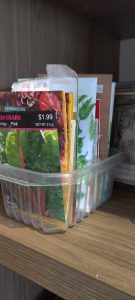Grow a Chaos Garden
Throw your Kids and your “Leftover Seed” collection onto a patch of dirt with a kids rake.

Your old unused seeds become a game.
Here’s the play:
Grab a patch of dirt.
Hand the kid the seed stash.
Let them dump everything out, all together, into one container.
Mix it up. Dump it out. Rake it all around
Sprinkle. Then… wait.
That’s it. No plan. No labels. Just watch what happens.
Set the expectation early: most of them will wither. That’s part of the game.
Then ask: Who hangs on the longest?
It becomes a living epic of:
-
What sprouts first?
-
What grows best?
-
What gets eaten by bugs?
-
What survives in this mess?
Which of these weird seedlings do we want to grow again, on purpose?
Turn It Into a Game
No scoreboard. Just curiosity.
Let the kids try to name the sprouts.
Use the seedling ID sites below – or just go wild and make it up.
Ask:
What do you think it is?
What does it remind you of?
What do you hope it turns out to be?
Sometimes they’ll guess right.
Sometimes they’ll invent names that deserve their own seed packet design.
The point isn’t to “get it.”
It’s to notice.
And hopefully… to wonder more.
What’s That Sprout?
Whether it’s a radish, a rogue beet, or something that blew in with the wind, there are ways to figure it out.
Here are some seedling ID tools (for plants and weeds) you can explore together:
- Need a quick visual? Watch these 3‑4 minute videos right here.
You don’t need to memorize anything. Just explore. Snap a pic if you’re heading indoors. You can match it later.
Sometimes you’re working to grow your food.
Sometimes you’re learning what grows without much help. (a top Gardener’s Secret)
Both matter.
What’s Under There?
If a plant comes up and you’re not sure what it is, look underneath.
Pull it gently and check the root:
-
Is it long and skinny like a carrot?
-
Is it round and stubby like a radish?
-
Is it a tangle of hair-thin roots?
-
Does it break off easily, or fight to stay in?
-
Does it have runner roots?
Some roots store food. Some grab water.
Some are tough enough to crack dry dirt.
Even the way a root lets go—or doesn’t—can tell you something.
Try lining up a few pulled weeds or extras.
Ask: Which one looks like it could survive a desert?
Or: Which one do you wish was a vegetable?
You don’t need answers. Just eyes.
The roots are talking too.
Got Scraps? Plant Those Too.
If the seed stash is slim, the fridge can play backup.
Try:
Celery bottoms
Beet tops
Potato eyes
Green onion ends
Carrot tops (they won’t regrow carrots, but they look cool)
Let the kids make their own “test row.”
No expectations. Just watch what happens.
And When a Weed Shows Up?
Four good questions to ask:
-
Can we eat it?
Look up purslane, lamb’s quarters, chickweed, dandelion. You might be walking past dinner. -
What’s it telling us?
Some weeds love clay. Others signal dry soil. Some pop up when your compost’s too rich. They’re talking. You just have to listen. -
Is it tough?
Because if it thrives in your mess without help… you might want more of it. -
Is it doing a job you are not aware of?
Some weeds shade the soil so it doesn’t bake.
Some hold the slope together after the rain.
Some bring up minerals from deep down where your lettuce roots never reach.
Some keep the bugs busy while your beans get a break.
Some just remind you that life’s still trying, even in dry dirt.
And when they die?
They become mulch.
Their roots soften the soil.
They feed what comes next.
If it’s doing something, anything you’re not doing, maybe that’s useful enough.
Not all weeds are villains. Some are pioneers.
That’s the whole game.
Don’t have a seed stash?
Start one.
Toss in kitchen leftovers.
Ask your neighbors for their forgotten seeds.
Some libraries have seed drawers. Just ask.
Some feed stores have bulk mixed seeds bins, CHEAP. (or is it cheep, cheep?)
If your stash is empty and you need a shortcut:
SAVE THE BEES! Garden Variety Pack – affiliate link
Final thought:
Failure is reframed as testing and learning.
Encourage observation and “wonderment”.
If everything dies, your dirt patch is now much better off than before you began!